Organisational Behaviour in Sainsbury's: Culture, Motivation, Teams
VerifiedAdded on 2023/06/07
|18
|5812
|430
Report
AI Summary
This report provides a comprehensive analysis of organisational behaviour within the context of Sainsbury's, a leading UK supermarket chain. It explores how organisational culture, politics, and power dynamics influence individual and team performance. The report examines various motivation theories, including content and process theories, and their role in achieving company goals. It also identifies factors that contribute to effective teamwork and critically analyses group development theories. Furthermore, the report delves into the philosophies and concepts of organisational behaviour, providing insights into how organisations can optimise their human resources and working environment to enhance overall performance. This detailed analysis is supported by relevant examples and theoretical frameworks, offering a valuable resource for understanding organisational behaviour in a real-world setting. Desklib provides access to a wide range of similar solved assignments and study materials for students.
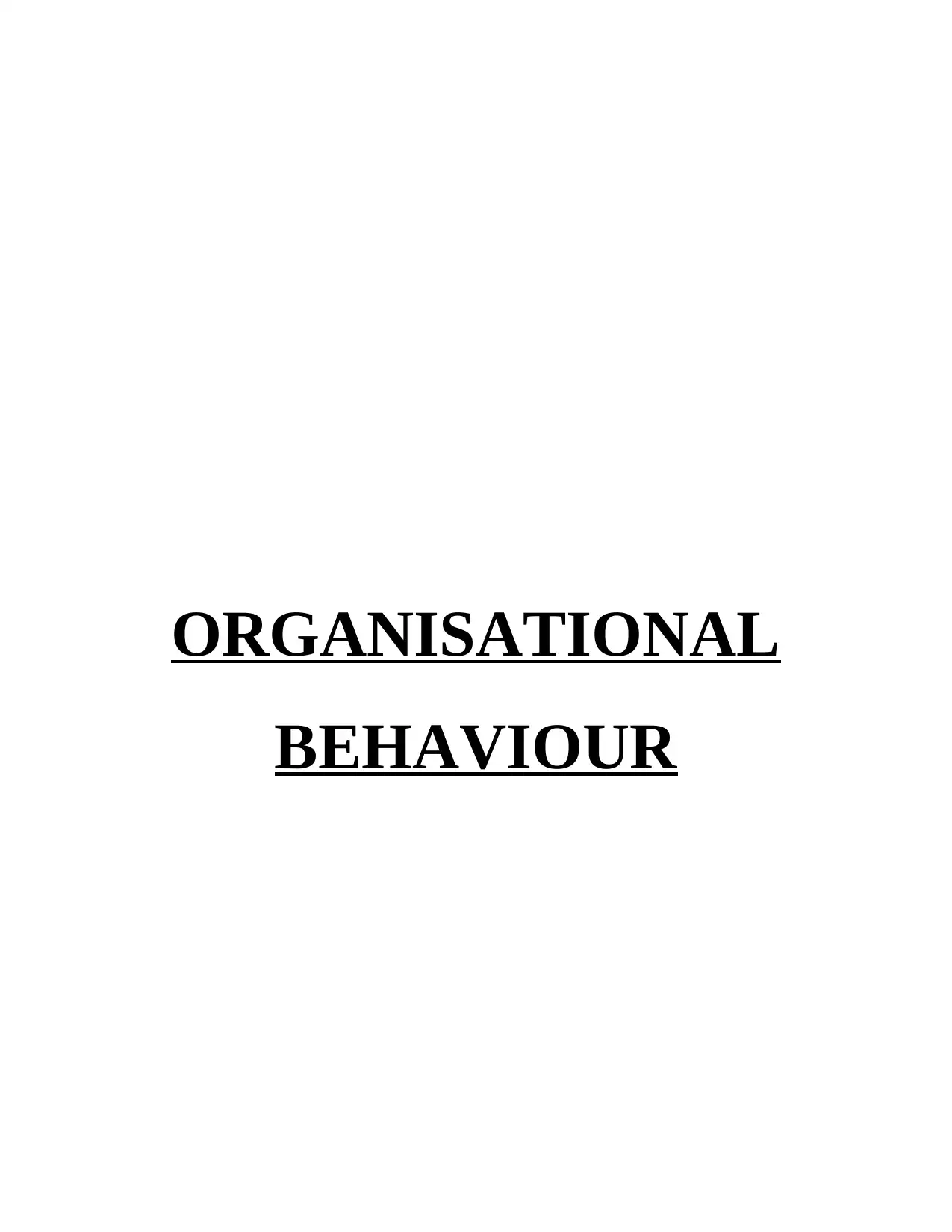
ORGANISATIONAL
BEHAVIOUR
BEHAVIOUR
Paraphrase This Document
Need a fresh take? Get an instant paraphrase of this document with our AI Paraphraser
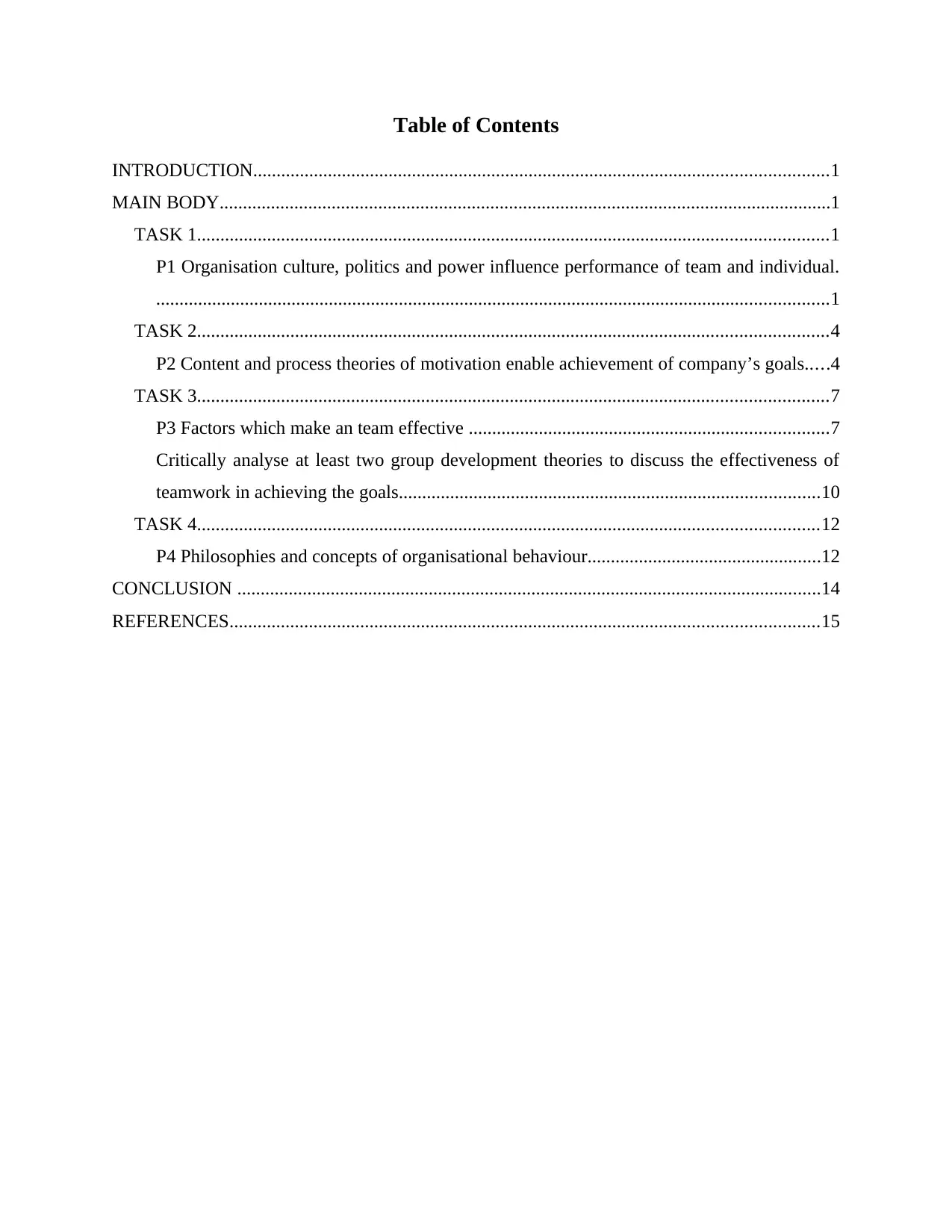
Table of Contents
INTRODUCTION...........................................................................................................................1
MAIN BODY...................................................................................................................................1
TASK 1.......................................................................................................................................1
P1 Organisation culture, politics and power influence performance of team and individual.
................................................................................................................................................1
TASK 2.......................................................................................................................................4
P2 Content and process theories of motivation enable achievement of company’s goals.....4
TASK 3.......................................................................................................................................7
P3 Factors which make an team effective .............................................................................7
Critically analyse at least two group development theories to discuss the effectiveness of
teamwork in achieving the goals..........................................................................................10
TASK 4.....................................................................................................................................12
P4 Philosophies and concepts of organisational behaviour..................................................12
CONCLUSION .............................................................................................................................14
REFERENCES..............................................................................................................................15
INTRODUCTION...........................................................................................................................1
MAIN BODY...................................................................................................................................1
TASK 1.......................................................................................................................................1
P1 Organisation culture, politics and power influence performance of team and individual.
................................................................................................................................................1
TASK 2.......................................................................................................................................4
P2 Content and process theories of motivation enable achievement of company’s goals.....4
TASK 3.......................................................................................................................................7
P3 Factors which make an team effective .............................................................................7
Critically analyse at least two group development theories to discuss the effectiveness of
teamwork in achieving the goals..........................................................................................10
TASK 4.....................................................................................................................................12
P4 Philosophies and concepts of organisational behaviour..................................................12
CONCLUSION .............................................................................................................................14
REFERENCES..............................................................................................................................15
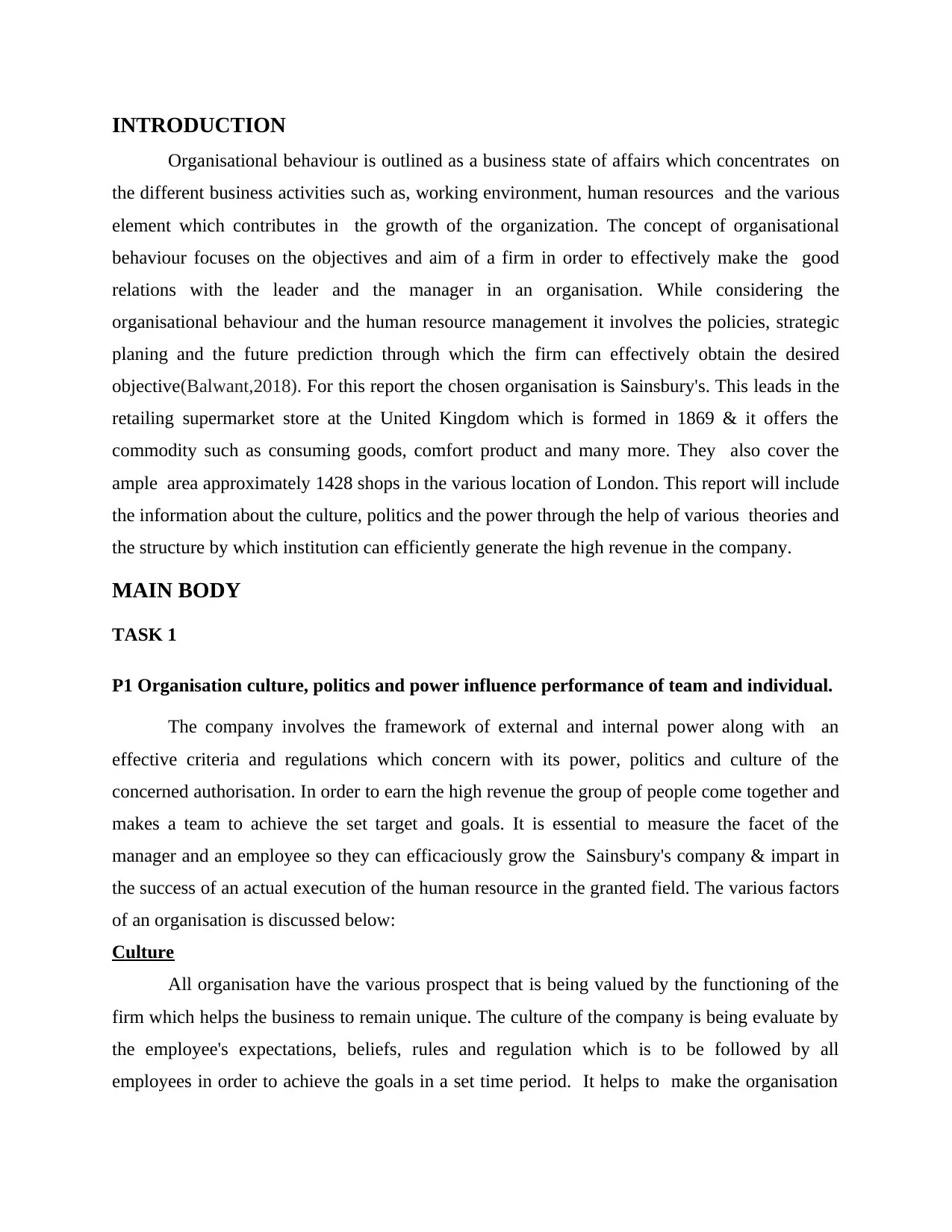
INTRODUCTION
Organisational behaviour is outlined as a business state of affairs which concentrates on
the different business activities such as, working environment, human resources and the various
element which contributes in the growth of the organization. The concept of organisational
behaviour focuses on the objectives and aim of a firm in order to effectively make the good
relations with the leader and the manager in an organisation. While considering the
organisational behaviour and the human resource management it involves the policies, strategic
planing and the future prediction through which the firm can effectively obtain the desired
objective(Balwant,2018). For this report the chosen organisation is Sainsbury's. This leads in the
retailing supermarket store at the United Kingdom which is formed in 1869 & it offers the
commodity such as consuming goods, comfort product and many more. They also cover the
ample area approximately 1428 shops in the various location of London. This report will include
the information about the culture, politics and the power through the help of various theories and
the structure by which institution can efficiently generate the high revenue in the company.
MAIN BODY
TASK 1
P1 Organisation culture, politics and power influence performance of team and individual.
The company involves the framework of external and internal power along with an
effective criteria and regulations which concern with its power, politics and culture of the
concerned authorisation. In order to earn the high revenue the group of people come together and
makes a team to achieve the set target and goals. It is essential to measure the facet of the
manager and an employee so they can efficaciously grow the Sainsbury's company & impart in
the success of an actual execution of the human resource in the granted field. The various factors
of an organisation is discussed below:
Culture
All organisation have the various prospect that is being valued by the functioning of the
firm which helps the business to remain unique. The culture of the company is being evaluate by
the employee's expectations, beliefs, rules and regulation which is to be followed by all
employees in order to achieve the goals in a set time period. It helps to make the organisation
Organisational behaviour is outlined as a business state of affairs which concentrates on
the different business activities such as, working environment, human resources and the various
element which contributes in the growth of the organization. The concept of organisational
behaviour focuses on the objectives and aim of a firm in order to effectively make the good
relations with the leader and the manager in an organisation. While considering the
organisational behaviour and the human resource management it involves the policies, strategic
planing and the future prediction through which the firm can effectively obtain the desired
objective(Balwant,2018). For this report the chosen organisation is Sainsbury's. This leads in the
retailing supermarket store at the United Kingdom which is formed in 1869 & it offers the
commodity such as consuming goods, comfort product and many more. They also cover the
ample area approximately 1428 shops in the various location of London. This report will include
the information about the culture, politics and the power through the help of various theories and
the structure by which institution can efficiently generate the high revenue in the company.
MAIN BODY
TASK 1
P1 Organisation culture, politics and power influence performance of team and individual.
The company involves the framework of external and internal power along with an
effective criteria and regulations which concern with its power, politics and culture of the
concerned authorisation. In order to earn the high revenue the group of people come together and
makes a team to achieve the set target and goals. It is essential to measure the facet of the
manager and an employee so they can efficaciously grow the Sainsbury's company & impart in
the success of an actual execution of the human resource in the granted field. The various factors
of an organisation is discussed below:
Culture
All organisation have the various prospect that is being valued by the functioning of the
firm which helps the business to remain unique. The culture of the company is being evaluate by
the employee's expectations, beliefs, rules and regulation which is to be followed by all
employees in order to achieve the goals in a set time period. It helps to make the organisation
⊘ This is a preview!⊘
Do you want full access?
Subscribe today to unlock all pages.

Trusted by 1+ million students worldwide
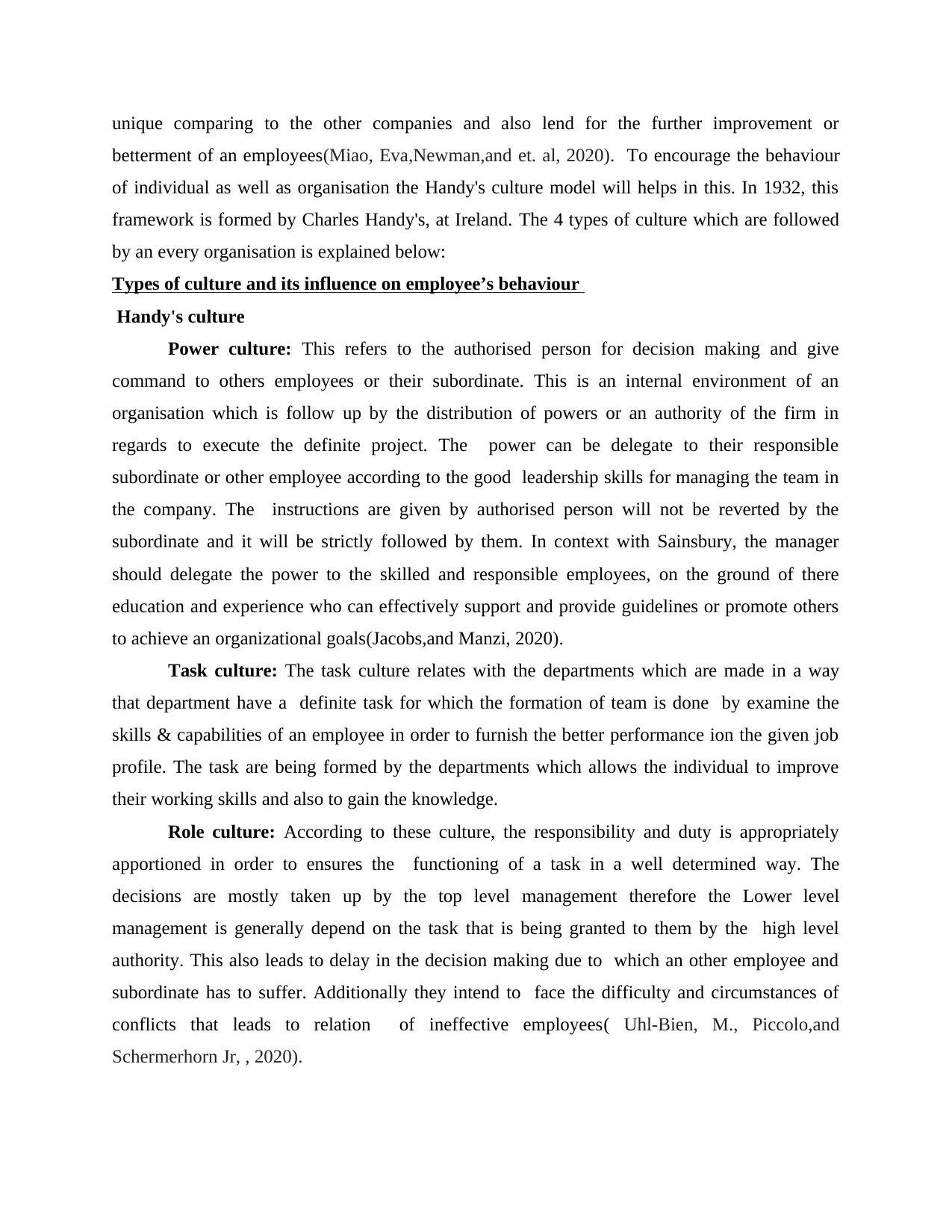
unique comparing to the other companies and also lend for the further improvement or
betterment of an employees(Miao, Eva,Newman,and et. al, 2020). To encourage the behaviour
of individual as well as organisation the Handy's culture model will helps in this. In 1932, this
framework is formed by Charles Handy's, at Ireland. The 4 types of culture which are followed
by an every organisation is explained below:
Types of culture and its influence on employee’s behaviour
Handy's culture
Power culture: This refers to the authorised person for decision making and give
command to others employees or their subordinate. This is an internal environment of an
organisation which is follow up by the distribution of powers or an authority of the firm in
regards to execute the definite project. The power can be delegate to their responsible
subordinate or other employee according to the good leadership skills for managing the team in
the company. The instructions are given by authorised person will not be reverted by the
subordinate and it will be strictly followed by them. In context with Sainsbury, the manager
should delegate the power to the skilled and responsible employees, on the ground of there
education and experience who can effectively support and provide guidelines or promote others
to achieve an organizational goals(Jacobs,and Manzi, 2020).
Task culture: The task culture relates with the departments which are made in a way
that department have a definite task for which the formation of team is done by examine the
skills & capabilities of an employee in order to furnish the better performance ion the given job
profile. The task are being formed by the departments which allows the individual to improve
their working skills and also to gain the knowledge.
Role culture: According to these culture, the responsibility and duty is appropriately
apportioned in order to ensures the functioning of a task in a well determined way. The
decisions are mostly taken up by the top level management therefore the Lower level
management is generally depend on the task that is being granted to them by the high level
authority. This also leads to delay in the decision making due to which an other employee and
subordinate has to suffer. Additionally they intend to face the difficulty and circumstances of
conflicts that leads to relation of ineffective employees( Uhl-Bien, M., Piccolo,and
Schermerhorn Jr, , 2020).
betterment of an employees(Miao, Eva,Newman,and et. al, 2020). To encourage the behaviour
of individual as well as organisation the Handy's culture model will helps in this. In 1932, this
framework is formed by Charles Handy's, at Ireland. The 4 types of culture which are followed
by an every organisation is explained below:
Types of culture and its influence on employee’s behaviour
Handy's culture
Power culture: This refers to the authorised person for decision making and give
command to others employees or their subordinate. This is an internal environment of an
organisation which is follow up by the distribution of powers or an authority of the firm in
regards to execute the definite project. The power can be delegate to their responsible
subordinate or other employee according to the good leadership skills for managing the team in
the company. The instructions are given by authorised person will not be reverted by the
subordinate and it will be strictly followed by them. In context with Sainsbury, the manager
should delegate the power to the skilled and responsible employees, on the ground of there
education and experience who can effectively support and provide guidelines or promote others
to achieve an organizational goals(Jacobs,and Manzi, 2020).
Task culture: The task culture relates with the departments which are made in a way
that department have a definite task for which the formation of team is done by examine the
skills & capabilities of an employee in order to furnish the better performance ion the given job
profile. The task are being formed by the departments which allows the individual to improve
their working skills and also to gain the knowledge.
Role culture: According to these culture, the responsibility and duty is appropriately
apportioned in order to ensures the functioning of a task in a well determined way. The
decisions are mostly taken up by the top level management therefore the Lower level
management is generally depend on the task that is being granted to them by the high level
authority. This also leads to delay in the decision making due to which an other employee and
subordinate has to suffer. Additionally they intend to face the difficulty and circumstances of
conflicts that leads to relation of ineffective employees( Uhl-Bien, M., Piccolo,and
Schermerhorn Jr, , 2020).
Paraphrase This Document
Need a fresh take? Get an instant paraphrase of this document with our AI Paraphraser
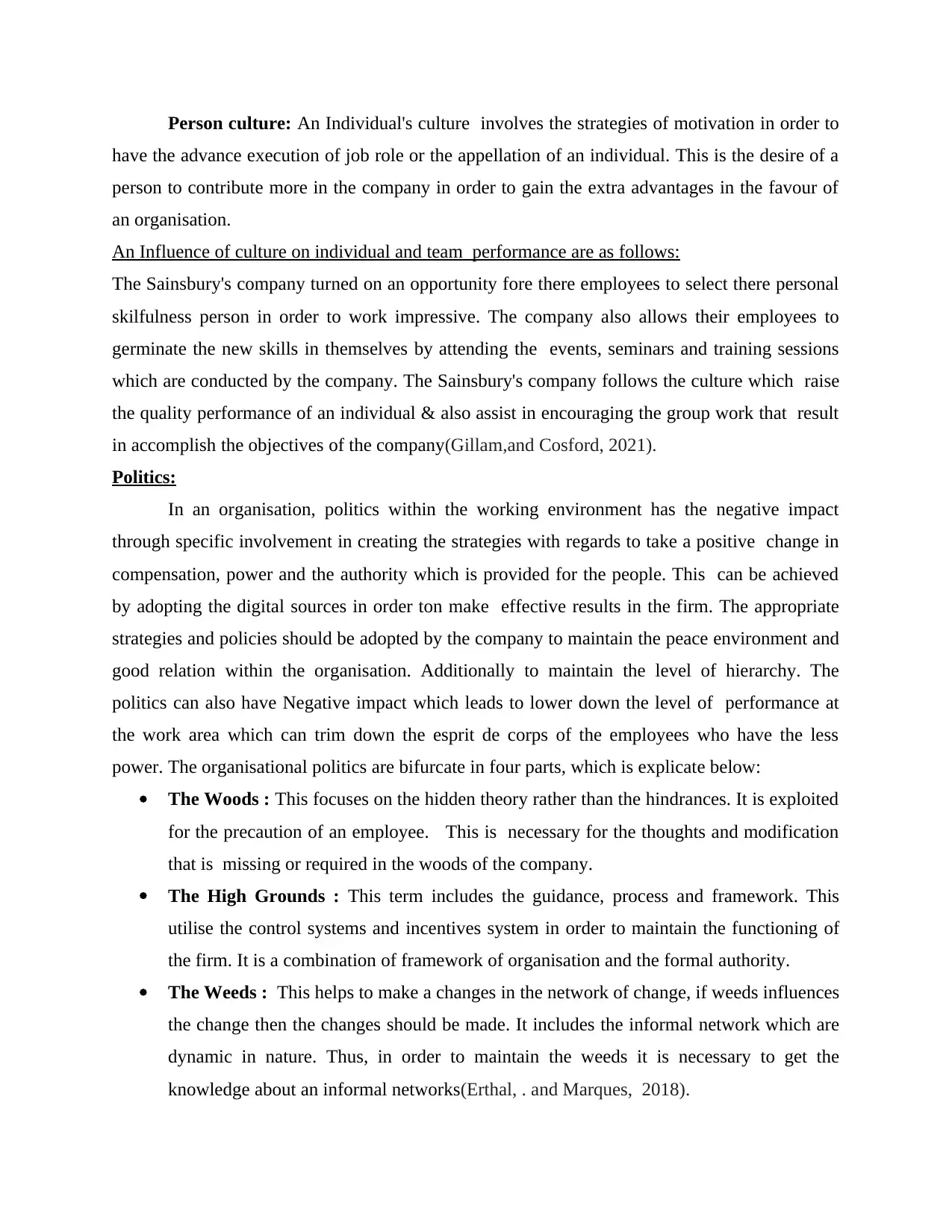
Person culture: An Individual's culture involves the strategies of motivation in order to
have the advance execution of job role or the appellation of an individual. This is the desire of a
person to contribute more in the company in order to gain the extra advantages in the favour of
an organisation.
An Influence of culture on individual and team performance are as follows:
The Sainsbury's company turned on an opportunity fore there employees to select there personal
skilfulness person in order to work impressive. The company also allows their employees to
germinate the new skills in themselves by attending the events, seminars and training sessions
which are conducted by the company. The Sainsbury's company follows the culture which raise
the quality performance of an individual & also assist in encouraging the group work that result
in accomplish the objectives of the company(Gillam,and Cosford, 2021).
Politics:
In an organisation, politics within the working environment has the negative impact
through specific involvement in creating the strategies with regards to take a positive change in
compensation, power and the authority which is provided for the people. This can be achieved
by adopting the digital sources in order ton make effective results in the firm. The appropriate
strategies and policies should be adopted by the company to maintain the peace environment and
good relation within the organisation. Additionally to maintain the level of hierarchy. The
politics can also have Negative impact which leads to lower down the level of performance at
the work area which can trim down the esprit de corps of the employees who have the less
power. The organisational politics are bifurcate in four parts, which is explicate below:
The Woods : This focuses on the hidden theory rather than the hindrances. It is exploited
for the precaution of an employee. This is necessary for the thoughts and modification
that is missing or required in the woods of the company.
The High Grounds : This term includes the guidance, process and framework. This
utilise the control systems and incentives system in order to maintain the functioning of
the firm. It is a combination of framework of organisation and the formal authority.
The Weeds : This helps to make a changes in the network of change, if weeds influences
the change then the changes should be made. It includes the informal network which are
dynamic in nature. Thus, in order to maintain the weeds it is necessary to get the
knowledge about an informal networks(Erthal, . and Marques, 2018).
have the advance execution of job role or the appellation of an individual. This is the desire of a
person to contribute more in the company in order to gain the extra advantages in the favour of
an organisation.
An Influence of culture on individual and team performance are as follows:
The Sainsbury's company turned on an opportunity fore there employees to select there personal
skilfulness person in order to work impressive. The company also allows their employees to
germinate the new skills in themselves by attending the events, seminars and training sessions
which are conducted by the company. The Sainsbury's company follows the culture which raise
the quality performance of an individual & also assist in encouraging the group work that result
in accomplish the objectives of the company(Gillam,and Cosford, 2021).
Politics:
In an organisation, politics within the working environment has the negative impact
through specific involvement in creating the strategies with regards to take a positive change in
compensation, power and the authority which is provided for the people. This can be achieved
by adopting the digital sources in order ton make effective results in the firm. The appropriate
strategies and policies should be adopted by the company to maintain the peace environment and
good relation within the organisation. Additionally to maintain the level of hierarchy. The
politics can also have Negative impact which leads to lower down the level of performance at
the work area which can trim down the esprit de corps of the employees who have the less
power. The organisational politics are bifurcate in four parts, which is explicate below:
The Woods : This focuses on the hidden theory rather than the hindrances. It is exploited
for the precaution of an employee. This is necessary for the thoughts and modification
that is missing or required in the woods of the company.
The High Grounds : This term includes the guidance, process and framework. This
utilise the control systems and incentives system in order to maintain the functioning of
the firm. It is a combination of framework of organisation and the formal authority.
The Weeds : This helps to make a changes in the network of change, if weeds influences
the change then the changes should be made. It includes the informal network which are
dynamic in nature. Thus, in order to maintain the weeds it is necessary to get the
knowledge about an informal networks(Erthal, . and Marques, 2018).
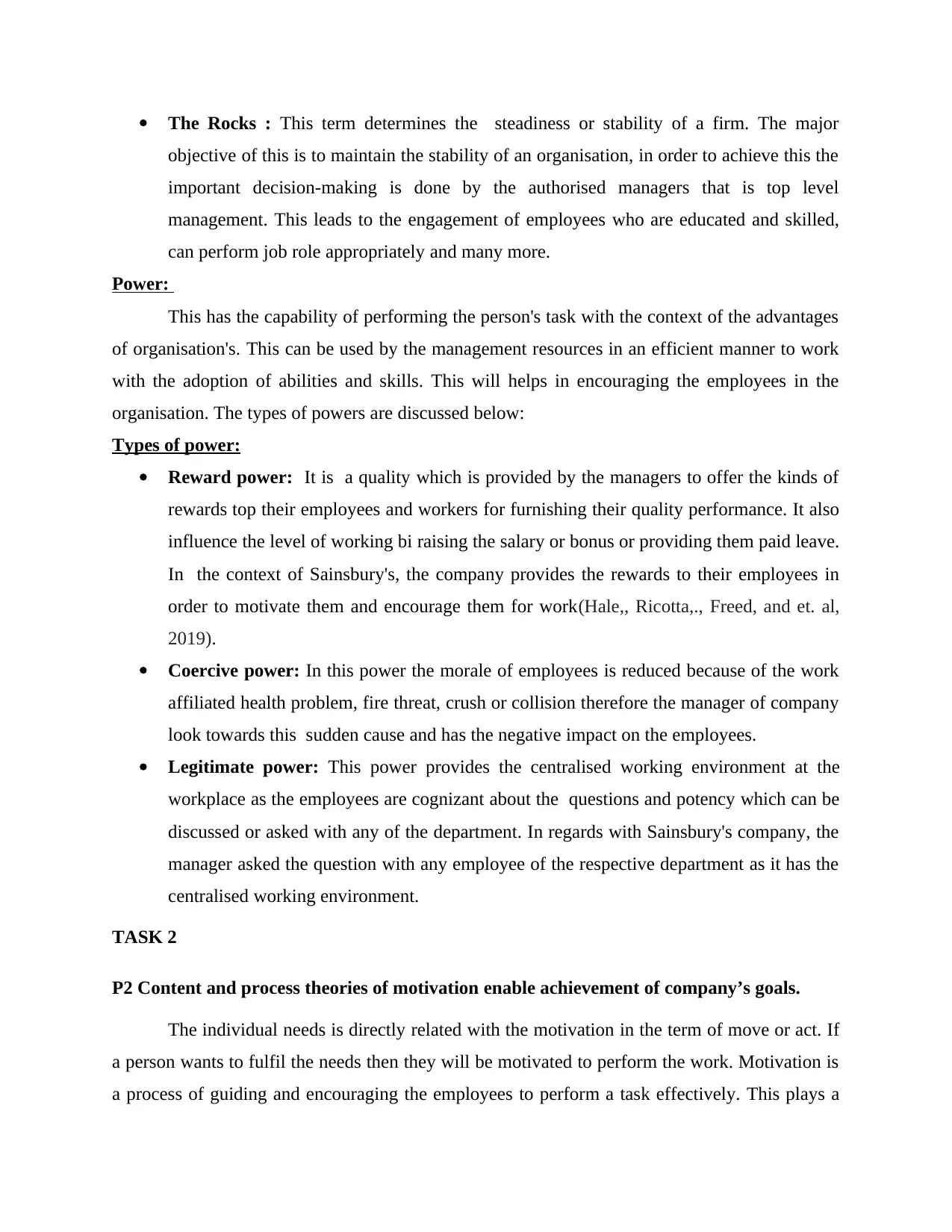
The Rocks : This term determines the steadiness or stability of a firm. The major
objective of this is to maintain the stability of an organisation, in order to achieve this the
important decision-making is done by the authorised managers that is top level
management. This leads to the engagement of employees who are educated and skilled,
can perform job role appropriately and many more.
Power:
This has the capability of performing the person's task with the context of the advantages
of organisation's. This can be used by the management resources in an efficient manner to work
with the adoption of abilities and skills. This will helps in encouraging the employees in the
organisation. The types of powers are discussed below:
Types of power:
Reward power: It is a quality which is provided by the managers to offer the kinds of
rewards top their employees and workers for furnishing their quality performance. It also
influence the level of working bi raising the salary or bonus or providing them paid leave.
In the context of Sainsbury's, the company provides the rewards to their employees in
order to motivate them and encourage them for work(Hale,, Ricotta,., Freed, and et. al,
2019).
Coercive power: In this power the morale of employees is reduced because of the work
affiliated health problem, fire threat, crush or collision therefore the manager of company
look towards this sudden cause and has the negative impact on the employees.
Legitimate power: This power provides the centralised working environment at the
workplace as the employees are cognizant about the questions and potency which can be
discussed or asked with any of the department. In regards with Sainsbury's company, the
manager asked the question with any employee of the respective department as it has the
centralised working environment.
TASK 2
P2 Content and process theories of motivation enable achievement of company’s goals.
The individual needs is directly related with the motivation in the term of move or act. If
a person wants to fulfil the needs then they will be motivated to perform the work. Motivation is
a process of guiding and encouraging the employees to perform a task effectively. This plays a
objective of this is to maintain the stability of an organisation, in order to achieve this the
important decision-making is done by the authorised managers that is top level
management. This leads to the engagement of employees who are educated and skilled,
can perform job role appropriately and many more.
Power:
This has the capability of performing the person's task with the context of the advantages
of organisation's. This can be used by the management resources in an efficient manner to work
with the adoption of abilities and skills. This will helps in encouraging the employees in the
organisation. The types of powers are discussed below:
Types of power:
Reward power: It is a quality which is provided by the managers to offer the kinds of
rewards top their employees and workers for furnishing their quality performance. It also
influence the level of working bi raising the salary or bonus or providing them paid leave.
In the context of Sainsbury's, the company provides the rewards to their employees in
order to motivate them and encourage them for work(Hale,, Ricotta,., Freed, and et. al,
2019).
Coercive power: In this power the morale of employees is reduced because of the work
affiliated health problem, fire threat, crush or collision therefore the manager of company
look towards this sudden cause and has the negative impact on the employees.
Legitimate power: This power provides the centralised working environment at the
workplace as the employees are cognizant about the questions and potency which can be
discussed or asked with any of the department. In regards with Sainsbury's company, the
manager asked the question with any employee of the respective department as it has the
centralised working environment.
TASK 2
P2 Content and process theories of motivation enable achievement of company’s goals.
The individual needs is directly related with the motivation in the term of move or act. If
a person wants to fulfil the needs then they will be motivated to perform the work. Motivation is
a process of guiding and encouraging the employees to perform a task effectively. This plays a
⊘ This is a preview!⊘
Do you want full access?
Subscribe today to unlock all pages.

Trusted by 1+ million students worldwide
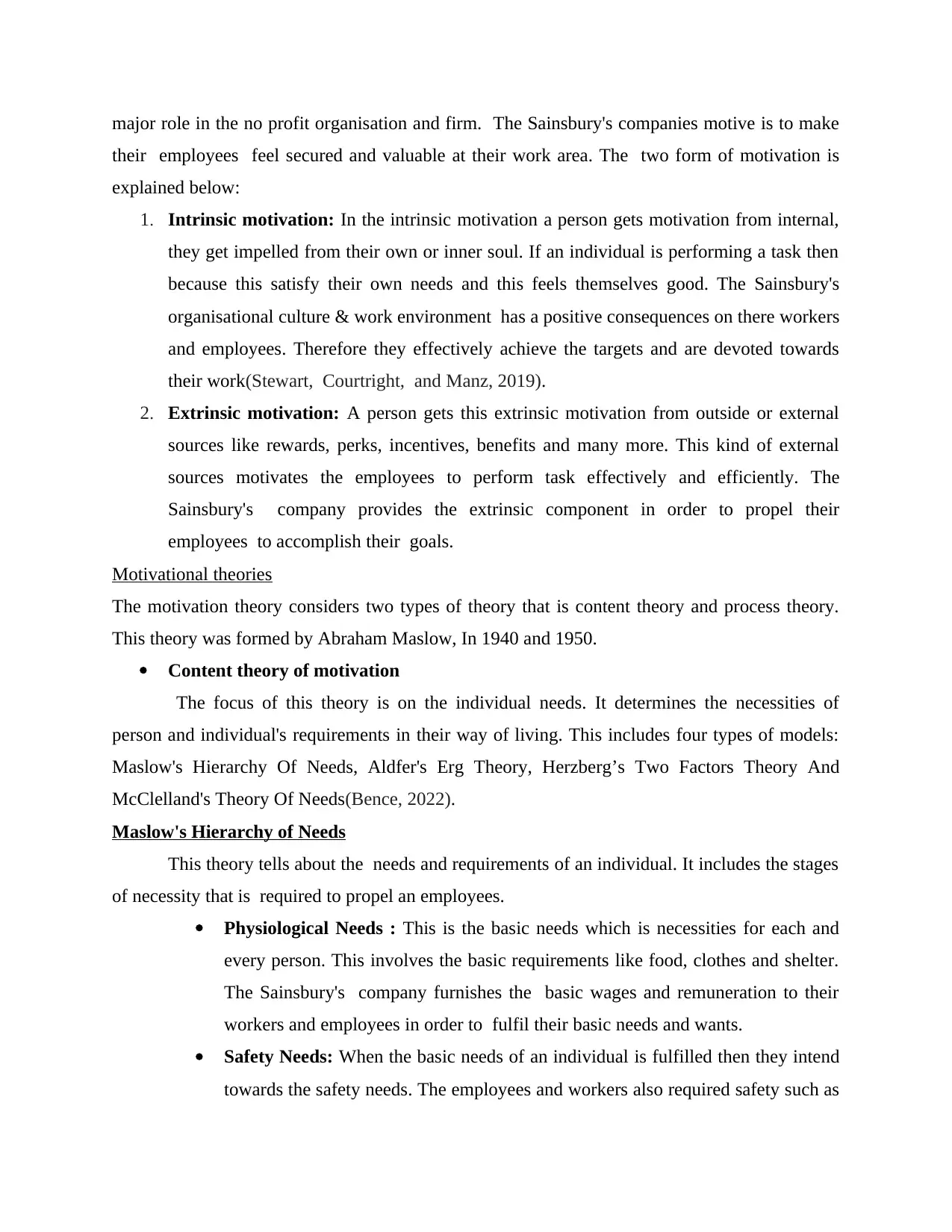
major role in the no profit organisation and firm. The Sainsbury's companies motive is to make
their employees feel secured and valuable at their work area. The two form of motivation is
explained below:
1. Intrinsic motivation: In the intrinsic motivation a person gets motivation from internal,
they get impelled from their own or inner soul. If an individual is performing a task then
because this satisfy their own needs and this feels themselves good. The Sainsbury's
organisational culture & work environment has a positive consequences on there workers
and employees. Therefore they effectively achieve the targets and are devoted towards
their work(Stewart, Courtright, and Manz, 2019).
2. Extrinsic motivation: A person gets this extrinsic motivation from outside or external
sources like rewards, perks, incentives, benefits and many more. This kind of external
sources motivates the employees to perform task effectively and efficiently. The
Sainsbury's company provides the extrinsic component in order to propel their
employees to accomplish their goals.
Motivational theories
The motivation theory considers two types of theory that is content theory and process theory.
This theory was formed by Abraham Maslow, In 1940 and 1950.
Content theory of motivation
The focus of this theory is on the individual needs. It determines the necessities of
person and individual's requirements in their way of living. This includes four types of models:
Maslow's Hierarchy Of Needs, Aldfer's Erg Theory, Herzberg’s Two Factors Theory And
McClelland's Theory Of Needs(Bence, 2022).
Maslow's Hierarchy of Needs
This theory tells about the needs and requirements of an individual. It includes the stages
of necessity that is required to propel an employees.
Physiological Needs : This is the basic needs which is necessities for each and
every person. This involves the basic requirements like food, clothes and shelter.
The Sainsbury's company furnishes the basic wages and remuneration to their
workers and employees in order to fulfil their basic needs and wants.
Safety Needs: When the basic needs of an individual is fulfilled then they intend
towards the safety needs. The employees and workers also required safety such as
their employees feel secured and valuable at their work area. The two form of motivation is
explained below:
1. Intrinsic motivation: In the intrinsic motivation a person gets motivation from internal,
they get impelled from their own or inner soul. If an individual is performing a task then
because this satisfy their own needs and this feels themselves good. The Sainsbury's
organisational culture & work environment has a positive consequences on there workers
and employees. Therefore they effectively achieve the targets and are devoted towards
their work(Stewart, Courtright, and Manz, 2019).
2. Extrinsic motivation: A person gets this extrinsic motivation from outside or external
sources like rewards, perks, incentives, benefits and many more. This kind of external
sources motivates the employees to perform task effectively and efficiently. The
Sainsbury's company provides the extrinsic component in order to propel their
employees to accomplish their goals.
Motivational theories
The motivation theory considers two types of theory that is content theory and process theory.
This theory was formed by Abraham Maslow, In 1940 and 1950.
Content theory of motivation
The focus of this theory is on the individual needs. It determines the necessities of
person and individual's requirements in their way of living. This includes four types of models:
Maslow's Hierarchy Of Needs, Aldfer's Erg Theory, Herzberg’s Two Factors Theory And
McClelland's Theory Of Needs(Bence, 2022).
Maslow's Hierarchy of Needs
This theory tells about the needs and requirements of an individual. It includes the stages
of necessity that is required to propel an employees.
Physiological Needs : This is the basic needs which is necessities for each and
every person. This involves the basic requirements like food, clothes and shelter.
The Sainsbury's company furnishes the basic wages and remuneration to their
workers and employees in order to fulfil their basic needs and wants.
Safety Needs: When the basic needs of an individual is fulfilled then they intend
towards the safety needs. The employees and workers also required safety such as
Paraphrase This Document
Need a fresh take? Get an instant paraphrase of this document with our AI Paraphraser
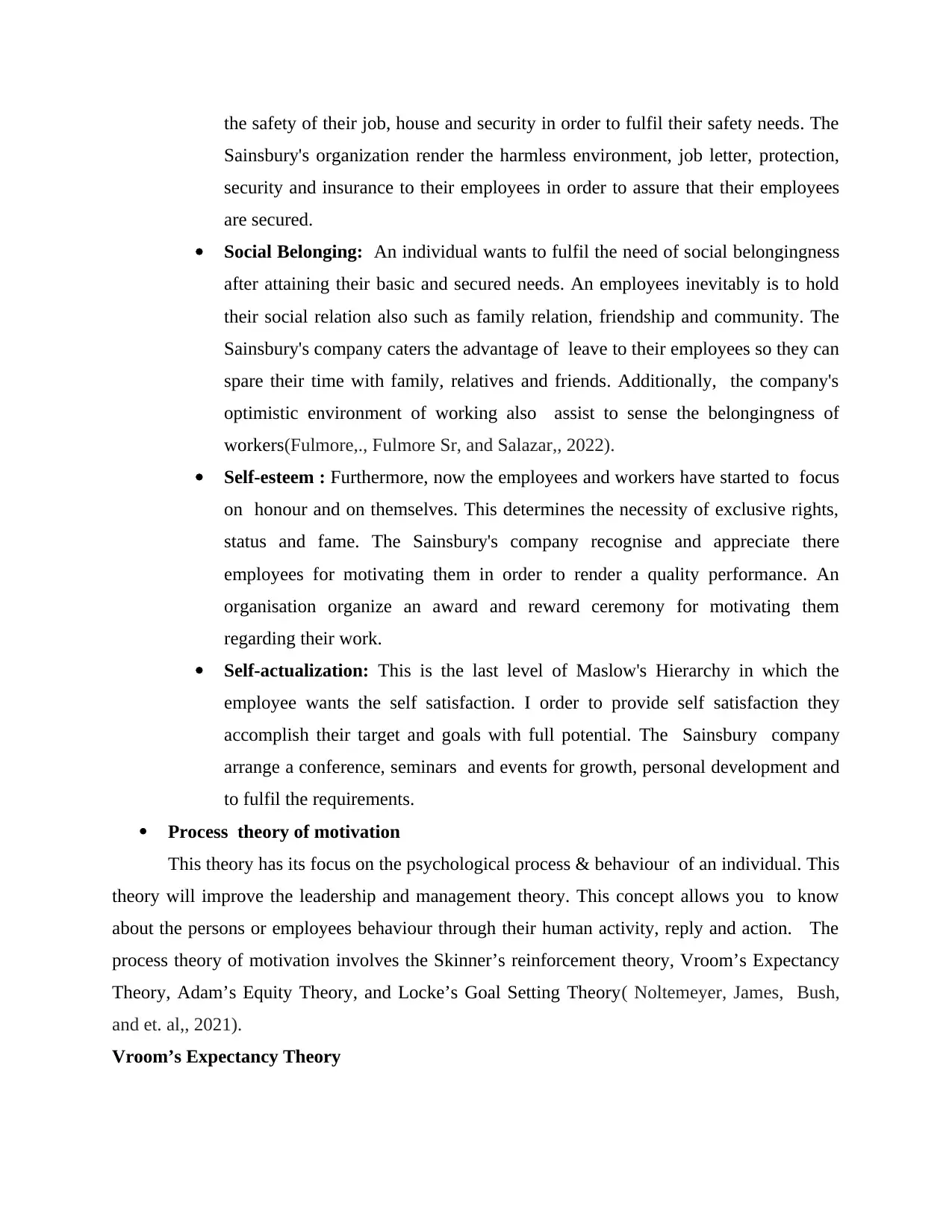
the safety of their job, house and security in order to fulfil their safety needs. The
Sainsbury's organization render the harmless environment, job letter, protection,
security and insurance to their employees in order to assure that their employees
are secured.
Social Belonging: An individual wants to fulfil the need of social belongingness
after attaining their basic and secured needs. An employees inevitably is to hold
their social relation also such as family relation, friendship and community. The
Sainsbury's company caters the advantage of leave to their employees so they can
spare their time with family, relatives and friends. Additionally, the company's
optimistic environment of working also assist to sense the belongingness of
workers(Fulmore,., Fulmore Sr, and Salazar,, 2022).
Self-esteem : Furthermore, now the employees and workers have started to focus
on honour and on themselves. This determines the necessity of exclusive rights,
status and fame. The Sainsbury's company recognise and appreciate there
employees for motivating them in order to render a quality performance. An
organisation organize an award and reward ceremony for motivating them
regarding their work.
Self-actualization: This is the last level of Maslow's Hierarchy in which the
employee wants the self satisfaction. I order to provide self satisfaction they
accomplish their target and goals with full potential. The Sainsbury company
arrange a conference, seminars and events for growth, personal development and
to fulfil the requirements.
Process theory of motivation
This theory has its focus on the psychological process & behaviour of an individual. This
theory will improve the leadership and management theory. This concept allows you to know
about the persons or employees behaviour through their human activity, reply and action. The
process theory of motivation involves the Skinner’s reinforcement theory, Vroom’s Expectancy
Theory, Adam’s Equity Theory, and Locke’s Goal Setting Theory( Noltemeyer, James, Bush,
and et. al,, 2021).
Vroom’s Expectancy Theory
Sainsbury's organization render the harmless environment, job letter, protection,
security and insurance to their employees in order to assure that their employees
are secured.
Social Belonging: An individual wants to fulfil the need of social belongingness
after attaining their basic and secured needs. An employees inevitably is to hold
their social relation also such as family relation, friendship and community. The
Sainsbury's company caters the advantage of leave to their employees so they can
spare their time with family, relatives and friends. Additionally, the company's
optimistic environment of working also assist to sense the belongingness of
workers(Fulmore,., Fulmore Sr, and Salazar,, 2022).
Self-esteem : Furthermore, now the employees and workers have started to focus
on honour and on themselves. This determines the necessity of exclusive rights,
status and fame. The Sainsbury's company recognise and appreciate there
employees for motivating them in order to render a quality performance. An
organisation organize an award and reward ceremony for motivating them
regarding their work.
Self-actualization: This is the last level of Maslow's Hierarchy in which the
employee wants the self satisfaction. I order to provide self satisfaction they
accomplish their target and goals with full potential. The Sainsbury company
arrange a conference, seminars and events for growth, personal development and
to fulfil the requirements.
Process theory of motivation
This theory has its focus on the psychological process & behaviour of an individual. This
theory will improve the leadership and management theory. This concept allows you to know
about the persons or employees behaviour through their human activity, reply and action. The
process theory of motivation involves the Skinner’s reinforcement theory, Vroom’s Expectancy
Theory, Adam’s Equity Theory, and Locke’s Goal Setting Theory( Noltemeyer, James, Bush,
and et. al,, 2021).
Vroom’s Expectancy Theory
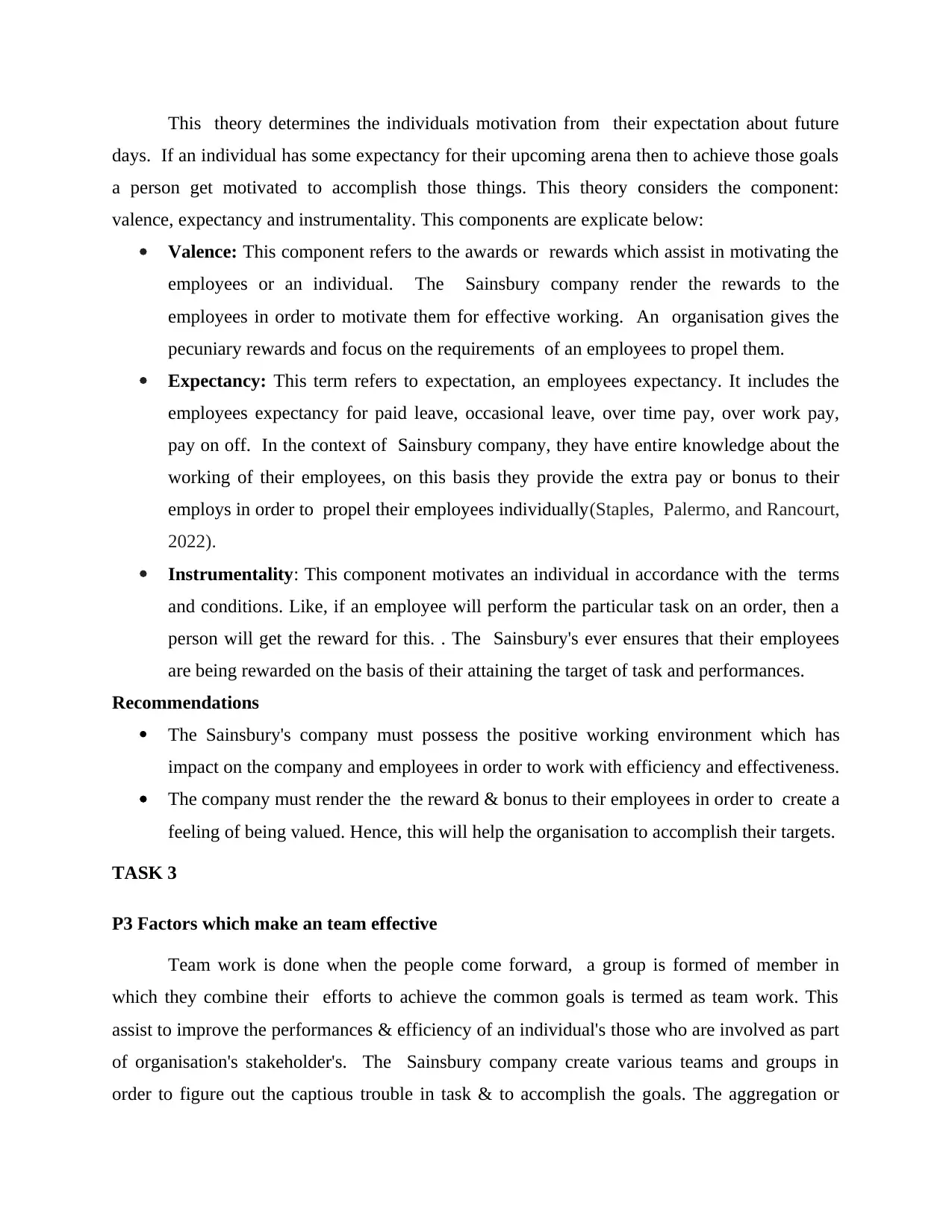
This theory determines the individuals motivation from their expectation about future
days. If an individual has some expectancy for their upcoming arena then to achieve those goals
a person get motivated to accomplish those things. This theory considers the component:
valence, expectancy and instrumentality. This components are explicate below:
Valence: This component refers to the awards or rewards which assist in motivating the
employees or an individual. The Sainsbury company render the rewards to the
employees in order to motivate them for effective working. An organisation gives the
pecuniary rewards and focus on the requirements of an employees to propel them.
Expectancy: This term refers to expectation, an employees expectancy. It includes the
employees expectancy for paid leave, occasional leave, over time pay, over work pay,
pay on off. In the context of Sainsbury company, they have entire knowledge about the
working of their employees, on this basis they provide the extra pay or bonus to their
employs in order to propel their employees individually(Staples, Palermo, and Rancourt,
2022).
Instrumentality: This component motivates an individual in accordance with the terms
and conditions. Like, if an employee will perform the particular task on an order, then a
person will get the reward for this. . The Sainsbury's ever ensures that their employees
are being rewarded on the basis of their attaining the target of task and performances.
Recommendations
The Sainsbury's company must possess the positive working environment which has
impact on the company and employees in order to work with efficiency and effectiveness.
The company must render the the reward & bonus to their employees in order to create a
feeling of being valued. Hence, this will help the organisation to accomplish their targets.
TASK 3
P3 Factors which make an team effective
Team work is done when the people come forward, a group is formed of member in
which they combine their efforts to achieve the common goals is termed as team work. This
assist to improve the performances & efficiency of an individual's those who are involved as part
of organisation's stakeholder's. The Sainsbury company create various teams and groups in
order to figure out the captious trouble in task & to accomplish the goals. The aggregation or
days. If an individual has some expectancy for their upcoming arena then to achieve those goals
a person get motivated to accomplish those things. This theory considers the component:
valence, expectancy and instrumentality. This components are explicate below:
Valence: This component refers to the awards or rewards which assist in motivating the
employees or an individual. The Sainsbury company render the rewards to the
employees in order to motivate them for effective working. An organisation gives the
pecuniary rewards and focus on the requirements of an employees to propel them.
Expectancy: This term refers to expectation, an employees expectancy. It includes the
employees expectancy for paid leave, occasional leave, over time pay, over work pay,
pay on off. In the context of Sainsbury company, they have entire knowledge about the
working of their employees, on this basis they provide the extra pay or bonus to their
employs in order to propel their employees individually(Staples, Palermo, and Rancourt,
2022).
Instrumentality: This component motivates an individual in accordance with the terms
and conditions. Like, if an employee will perform the particular task on an order, then a
person will get the reward for this. . The Sainsbury's ever ensures that their employees
are being rewarded on the basis of their attaining the target of task and performances.
Recommendations
The Sainsbury's company must possess the positive working environment which has
impact on the company and employees in order to work with efficiency and effectiveness.
The company must render the the reward & bonus to their employees in order to create a
feeling of being valued. Hence, this will help the organisation to accomplish their targets.
TASK 3
P3 Factors which make an team effective
Team work is done when the people come forward, a group is formed of member in
which they combine their efforts to achieve the common goals is termed as team work. This
assist to improve the performances & efficiency of an individual's those who are involved as part
of organisation's stakeholder's. The Sainsbury company create various teams and groups in
order to figure out the captious trouble in task & to accomplish the goals. The aggregation or
⊘ This is a preview!⊘
Do you want full access?
Subscribe today to unlock all pages.

Trusted by 1+ million students worldwide
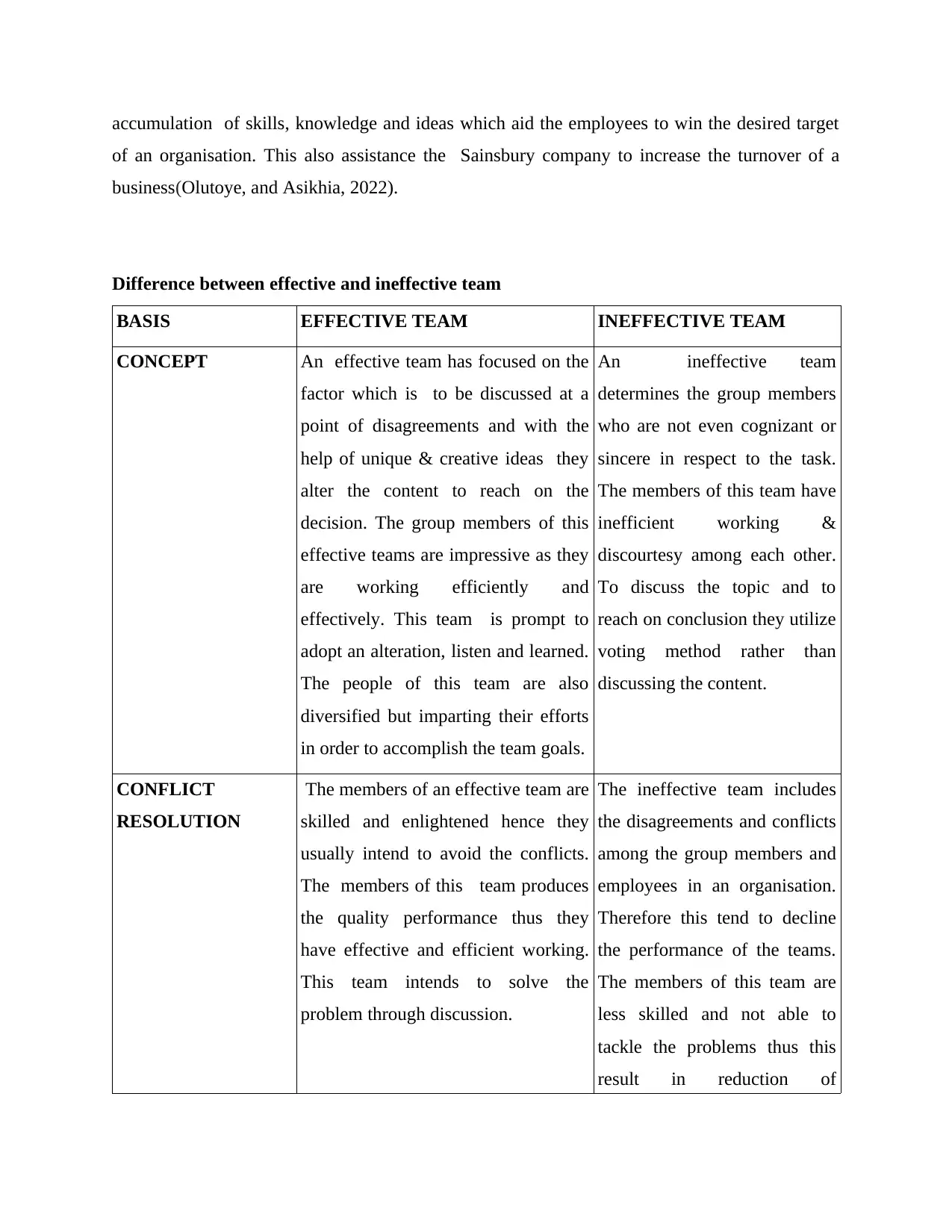
accumulation of skills, knowledge and ideas which aid the employees to win the desired target
of an organisation. This also assistance the Sainsbury company to increase the turnover of a
business(Olutoye, and Asikhia, 2022).
Difference between effective and ineffective team
BASIS EFFECTIVE TEAM INEFFECTIVE TEAM
CONCEPT An effective team has focused on the
factor which is to be discussed at a
point of disagreements and with the
help of unique & creative ideas they
alter the content to reach on the
decision. The group members of this
effective teams are impressive as they
are working efficiently and
effectively. This team is prompt to
adopt an alteration, listen and learned.
The people of this team are also
diversified but imparting their efforts
in order to accomplish the team goals.
An ineffective team
determines the group members
who are not even cognizant or
sincere in respect to the task.
The members of this team have
inefficient working &
discourtesy among each other.
To discuss the topic and to
reach on conclusion they utilize
voting method rather than
discussing the content.
CONFLICT
RESOLUTION
The members of an effective team are
skilled and enlightened hence they
usually intend to avoid the conflicts.
The members of this team produces
the quality performance thus they
have effective and efficient working.
This team intends to solve the
problem through discussion.
The ineffective team includes
the disagreements and conflicts
among the group members and
employees in an organisation.
Therefore this tend to decline
the performance of the teams.
The members of this team are
less skilled and not able to
tackle the problems thus this
result in reduction of
of an organisation. This also assistance the Sainsbury company to increase the turnover of a
business(Olutoye, and Asikhia, 2022).
Difference between effective and ineffective team
BASIS EFFECTIVE TEAM INEFFECTIVE TEAM
CONCEPT An effective team has focused on the
factor which is to be discussed at a
point of disagreements and with the
help of unique & creative ideas they
alter the content to reach on the
decision. The group members of this
effective teams are impressive as they
are working efficiently and
effectively. This team is prompt to
adopt an alteration, listen and learned.
The people of this team are also
diversified but imparting their efforts
in order to accomplish the team goals.
An ineffective team
determines the group members
who are not even cognizant or
sincere in respect to the task.
The members of this team have
inefficient working &
discourtesy among each other.
To discuss the topic and to
reach on conclusion they utilize
voting method rather than
discussing the content.
CONFLICT
RESOLUTION
The members of an effective team are
skilled and enlightened hence they
usually intend to avoid the conflicts.
The members of this team produces
the quality performance thus they
have effective and efficient working.
This team intends to solve the
problem through discussion.
The ineffective team includes
the disagreements and conflicts
among the group members and
employees in an organisation.
Therefore this tend to decline
the performance of the teams.
The members of this team are
less skilled and not able to
tackle the problems thus this
result in reduction of
Paraphrase This Document
Need a fresh take? Get an instant paraphrase of this document with our AI Paraphraser
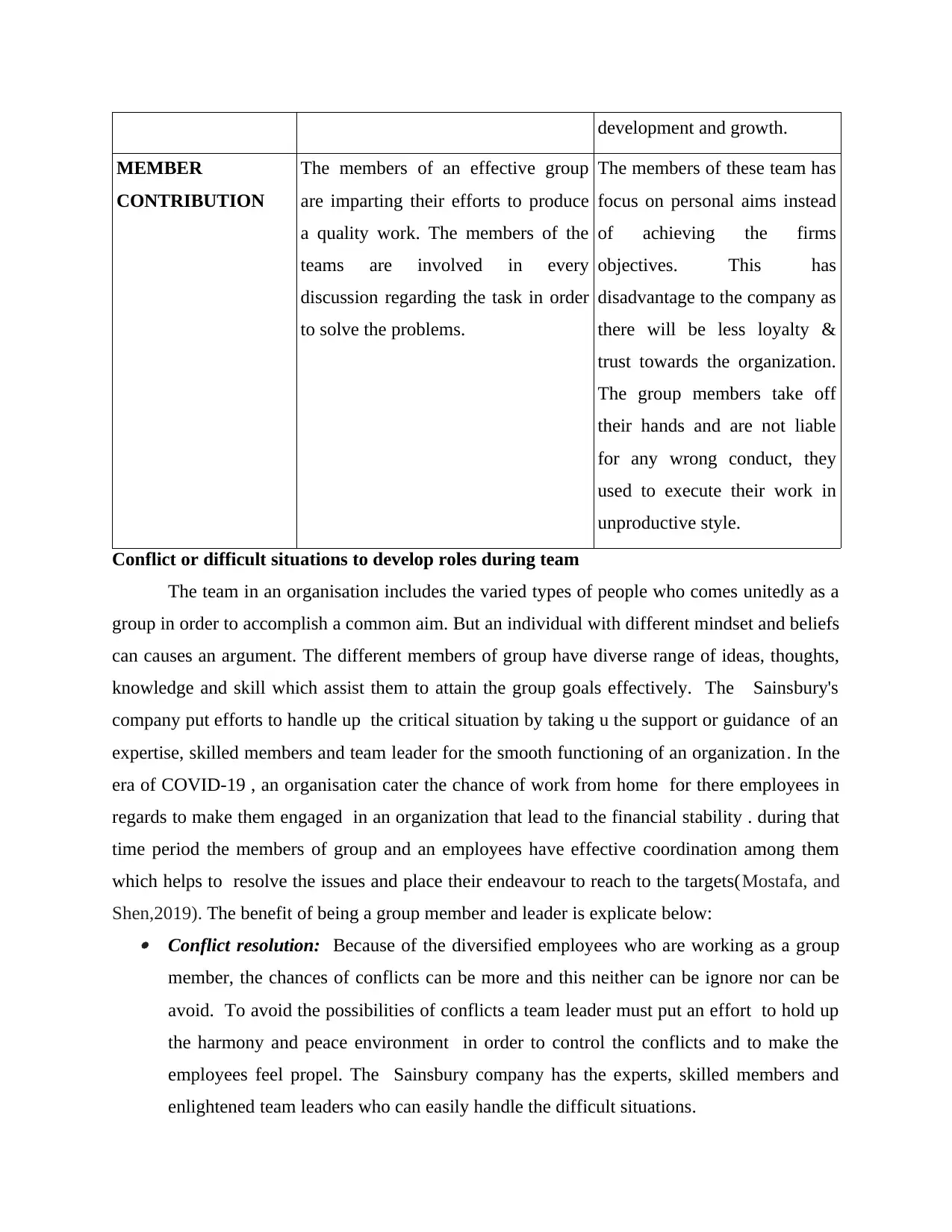
development and growth.
MEMBER
CONTRIBUTION
The members of an effective group
are imparting their efforts to produce
a quality work. The members of the
teams are involved in every
discussion regarding the task in order
to solve the problems.
The members of these team has
focus on personal aims instead
of achieving the firms
objectives. This has
disadvantage to the company as
there will be less loyalty &
trust towards the organization.
The group members take off
their hands and are not liable
for any wrong conduct, they
used to execute their work in
unproductive style.
Conflict or difficult situations to develop roles during team
The team in an organisation includes the varied types of people who comes unitedly as a
group in order to accomplish a common aim. But an individual with different mindset and beliefs
can causes an argument. The different members of group have diverse range of ideas, thoughts,
knowledge and skill which assist them to attain the group goals effectively. The Sainsbury's
company put efforts to handle up the critical situation by taking u the support or guidance of an
expertise, skilled members and team leader for the smooth functioning of an organization. In the
era of COVID-19 , an organisation cater the chance of work from home for there employees in
regards to make them engaged in an organization that lead to the financial stability . during that
time period the members of group and an employees have effective coordination among them
which helps to resolve the issues and place their endeavour to reach to the targets(Mostafa, and
Shen,2019). The benefit of being a group member and leader is explicate below: Conflict resolution: Because of the diversified employees who are working as a group
member, the chances of conflicts can be more and this neither can be ignore nor can be
avoid. To avoid the possibilities of conflicts a team leader must put an effort to hold up
the harmony and peace environment in order to control the conflicts and to make the
employees feel propel. The Sainsbury company has the experts, skilled members and
enlightened team leaders who can easily handle the difficult situations.
MEMBER
CONTRIBUTION
The members of an effective group
are imparting their efforts to produce
a quality work. The members of the
teams are involved in every
discussion regarding the task in order
to solve the problems.
The members of these team has
focus on personal aims instead
of achieving the firms
objectives. This has
disadvantage to the company as
there will be less loyalty &
trust towards the organization.
The group members take off
their hands and are not liable
for any wrong conduct, they
used to execute their work in
unproductive style.
Conflict or difficult situations to develop roles during team
The team in an organisation includes the varied types of people who comes unitedly as a
group in order to accomplish a common aim. But an individual with different mindset and beliefs
can causes an argument. The different members of group have diverse range of ideas, thoughts,
knowledge and skill which assist them to attain the group goals effectively. The Sainsbury's
company put efforts to handle up the critical situation by taking u the support or guidance of an
expertise, skilled members and team leader for the smooth functioning of an organization. In the
era of COVID-19 , an organisation cater the chance of work from home for there employees in
regards to make them engaged in an organization that lead to the financial stability . during that
time period the members of group and an employees have effective coordination among them
which helps to resolve the issues and place their endeavour to reach to the targets(Mostafa, and
Shen,2019). The benefit of being a group member and leader is explicate below: Conflict resolution: Because of the diversified employees who are working as a group
member, the chances of conflicts can be more and this neither can be ignore nor can be
avoid. To avoid the possibilities of conflicts a team leader must put an effort to hold up
the harmony and peace environment in order to control the conflicts and to make the
employees feel propel. The Sainsbury company has the experts, skilled members and
enlightened team leaders who can easily handle the difficult situations.
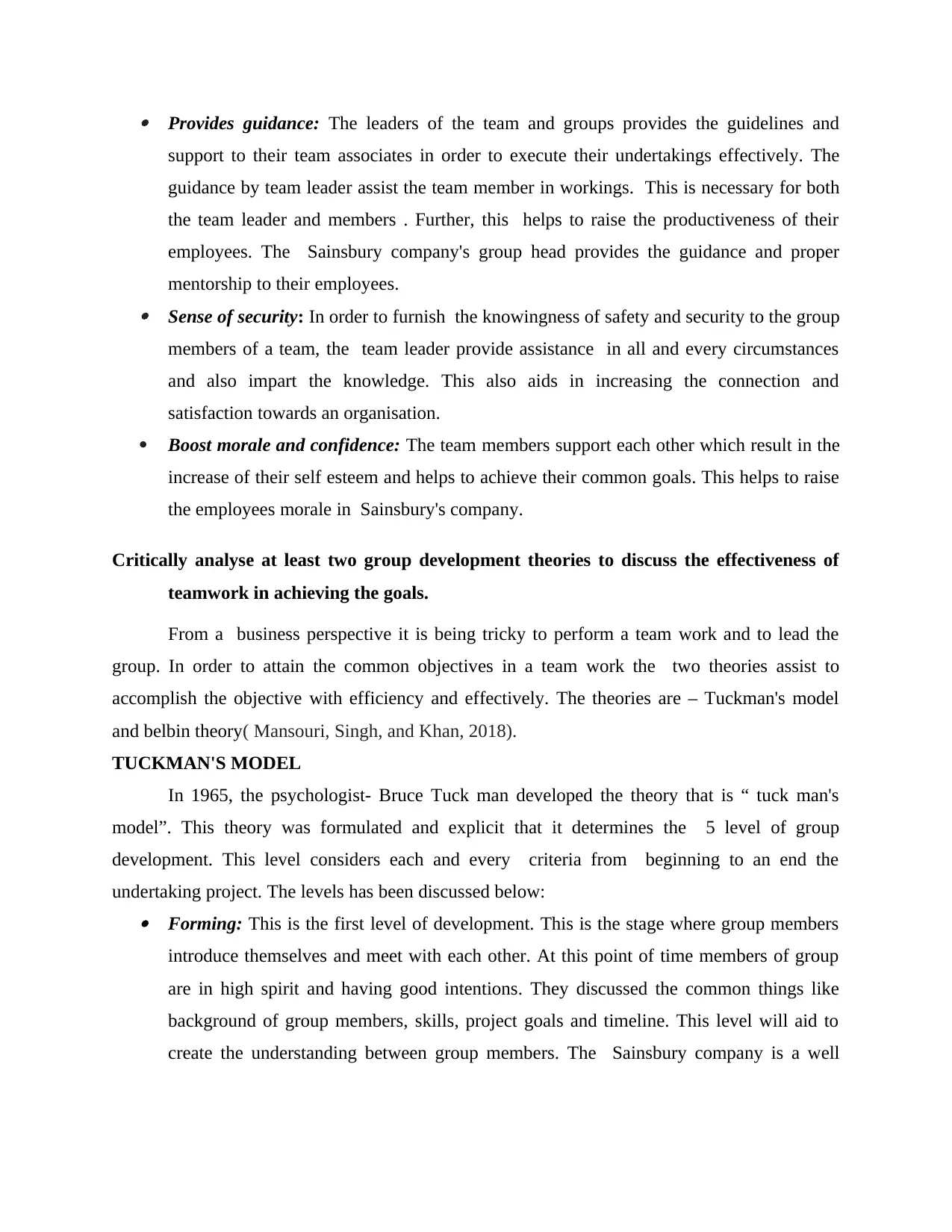
Provides guidance: The leaders of the team and groups provides the guidelines and
support to their team associates in order to execute their undertakings effectively. The
guidance by team leader assist the team member in workings. This is necessary for both
the team leader and members . Further, this helps to raise the productiveness of their
employees. The Sainsbury company's group head provides the guidance and proper
mentorship to their employees. Sense of security: In order to furnish the knowingness of safety and security to the group
members of a team, the team leader provide assistance in all and every circumstances
and also impart the knowledge. This also aids in increasing the connection and
satisfaction towards an organisation.
Boost morale and confidence: The team members support each other which result in the
increase of their self esteem and helps to achieve their common goals. This helps to raise
the employees morale in Sainsbury's company.
Critically analyse at least two group development theories to discuss the effectiveness of
teamwork in achieving the goals.
From a business perspective it is being tricky to perform a team work and to lead the
group. In order to attain the common objectives in a team work the two theories assist to
accomplish the objective with efficiency and effectively. The theories are – Tuckman's model
and belbin theory( Mansouri, Singh, and Khan, 2018).
TUCKMAN'S MODEL
In 1965, the psychologist- Bruce Tuck man developed the theory that is “ tuck man's
model”. This theory was formulated and explicit that it determines the 5 level of group
development. This level considers each and every criteria from beginning to an end the
undertaking project. The levels has been discussed below: Forming: This is the first level of development. This is the stage where group members
introduce themselves and meet with each other. At this point of time members of group
are in high spirit and having good intentions. They discussed the common things like
background of group members, skills, project goals and timeline. This level will aid to
create the understanding between group members. The Sainsbury company is a well
support to their team associates in order to execute their undertakings effectively. The
guidance by team leader assist the team member in workings. This is necessary for both
the team leader and members . Further, this helps to raise the productiveness of their
employees. The Sainsbury company's group head provides the guidance and proper
mentorship to their employees. Sense of security: In order to furnish the knowingness of safety and security to the group
members of a team, the team leader provide assistance in all and every circumstances
and also impart the knowledge. This also aids in increasing the connection and
satisfaction towards an organisation.
Boost morale and confidence: The team members support each other which result in the
increase of their self esteem and helps to achieve their common goals. This helps to raise
the employees morale in Sainsbury's company.
Critically analyse at least two group development theories to discuss the effectiveness of
teamwork in achieving the goals.
From a business perspective it is being tricky to perform a team work and to lead the
group. In order to attain the common objectives in a team work the two theories assist to
accomplish the objective with efficiency and effectively. The theories are – Tuckman's model
and belbin theory( Mansouri, Singh, and Khan, 2018).
TUCKMAN'S MODEL
In 1965, the psychologist- Bruce Tuck man developed the theory that is “ tuck man's
model”. This theory was formulated and explicit that it determines the 5 level of group
development. This level considers each and every criteria from beginning to an end the
undertaking project. The levels has been discussed below: Forming: This is the first level of development. This is the stage where group members
introduce themselves and meet with each other. At this point of time members of group
are in high spirit and having good intentions. They discussed the common things like
background of group members, skills, project goals and timeline. This level will aid to
create the understanding between group members. The Sainsbury company is a well
⊘ This is a preview!⊘
Do you want full access?
Subscribe today to unlock all pages.

Trusted by 1+ million students worldwide
1 out of 18
Related Documents
Your All-in-One AI-Powered Toolkit for Academic Success.
+13062052269
info@desklib.com
Available 24*7 on WhatsApp / Email
![[object Object]](/_next/static/media/star-bottom.7253800d.svg)
Unlock your academic potential
Copyright © 2020–2025 A2Z Services. All Rights Reserved. Developed and managed by ZUCOL.




